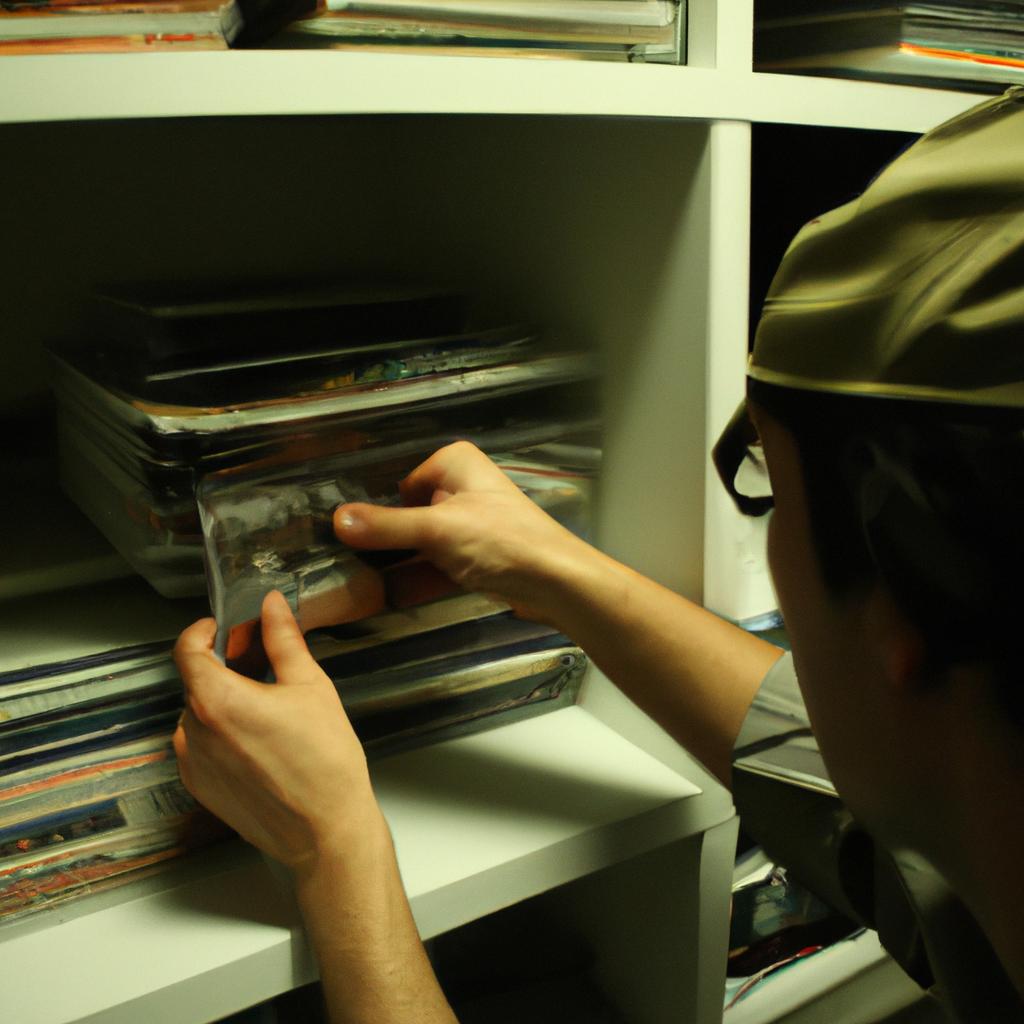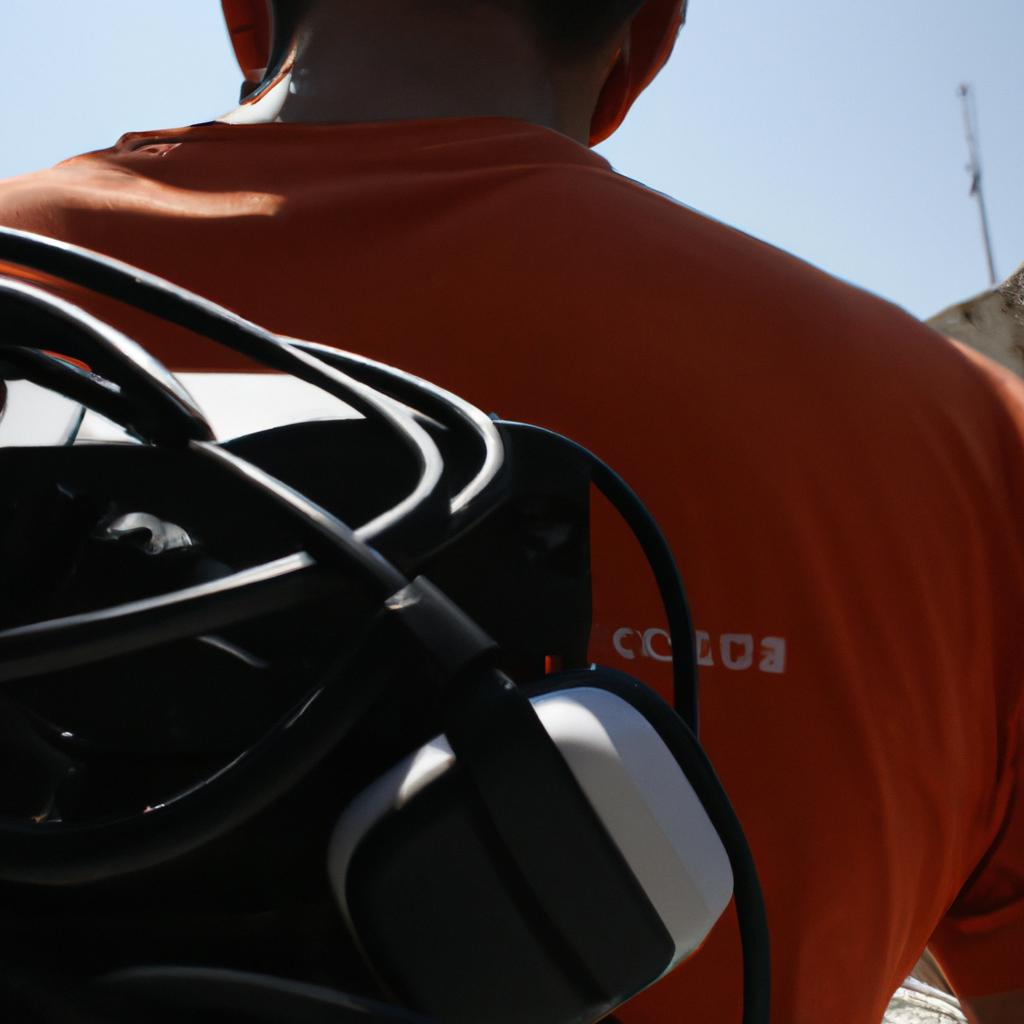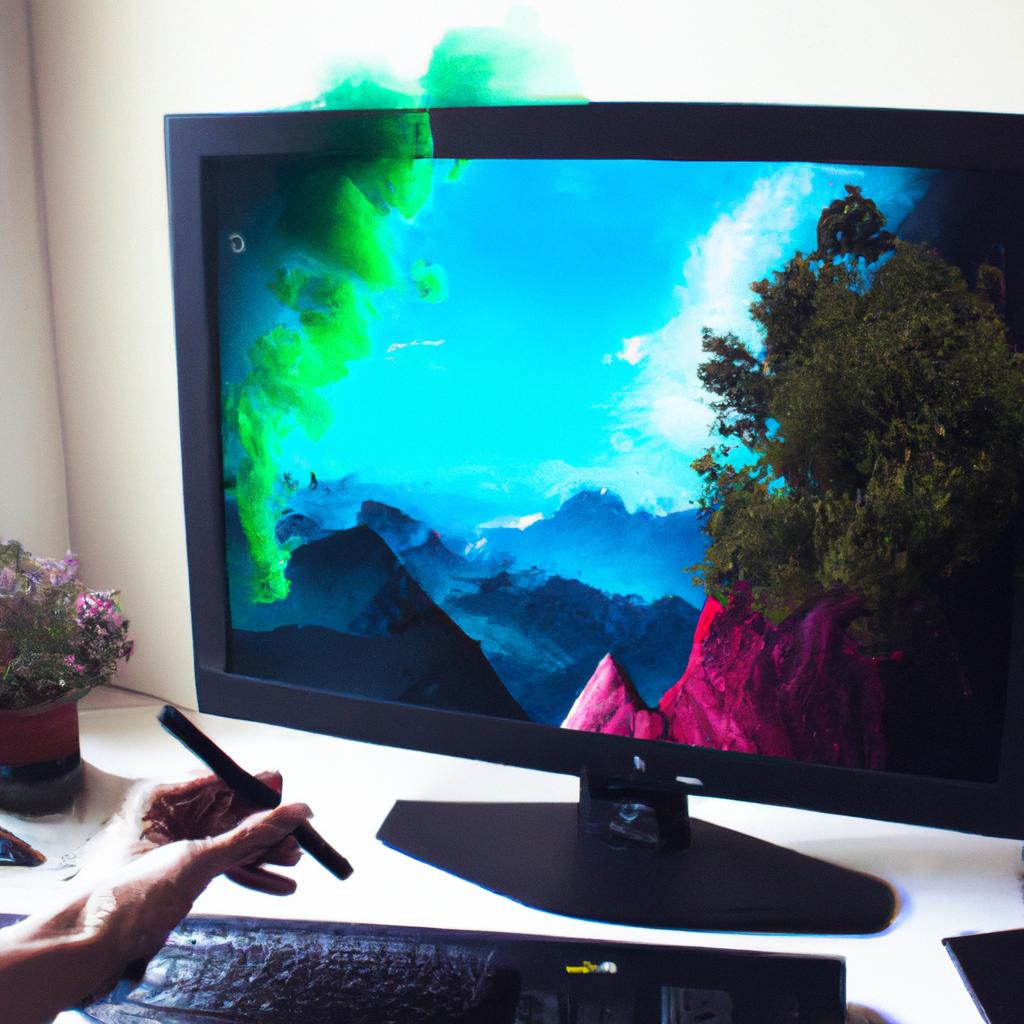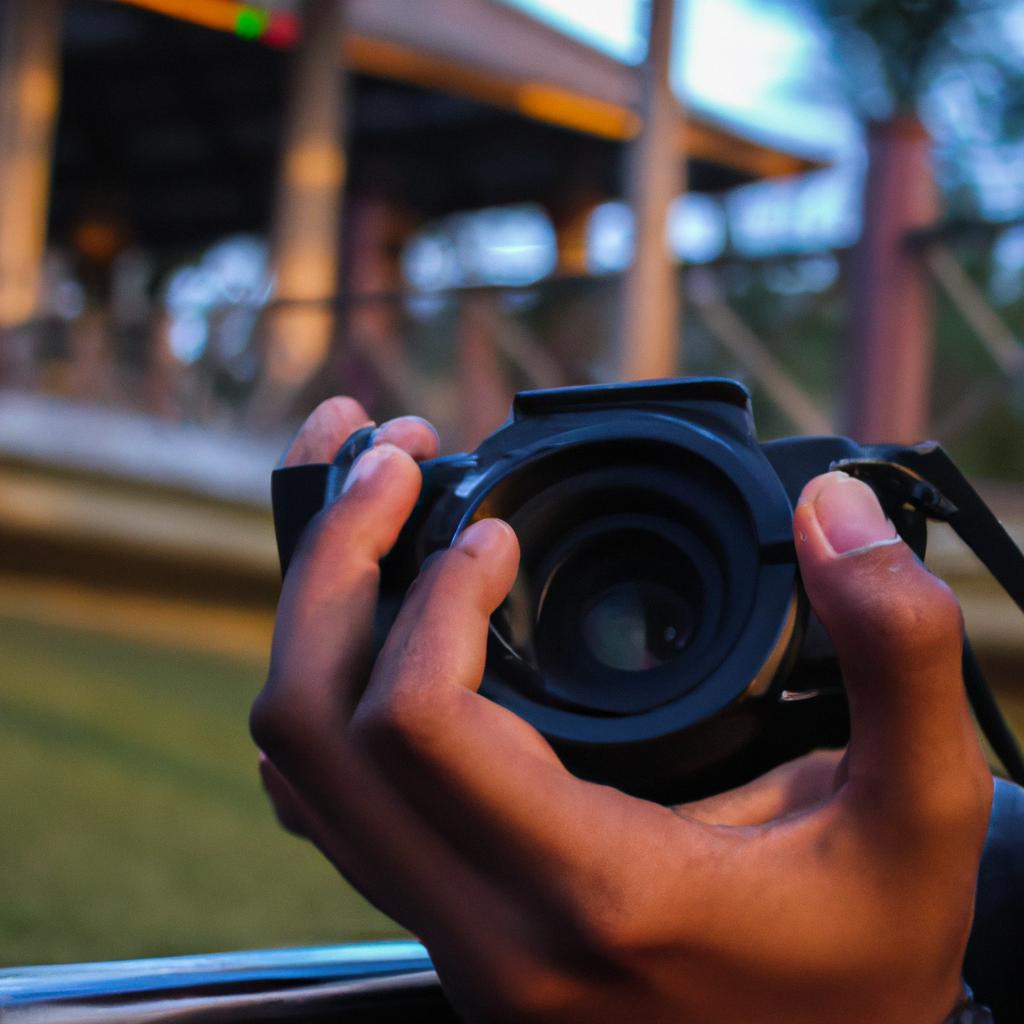Archival footage, a key component of television documentaries, serves as a catalyst in the portrayal and interpretation of historical events. By drawing upon existing audiovisual materials such as photographs, film reels, and video recordings from various sources, this practice allows filmmakers to construct narratives that provide viewers with an immersive experience of the past. For instance, imagine a documentary exploring the life and legacy of Martin Luther King Jr., where archival footage captures his iconic speeches and pivotal moments during the Civil Rights Movement. In examining how archival material is employed within television documentaries as an artistic tool, this article aims to shed light on its significance in shaping our understanding of history.
Within the realm of artistry, television documentaries employ archival footage not only for its factual accuracy but also for its ability to evoke emotions and generate a sense of authenticity. The inclusion of original visual content can transport viewers back in time by offering glimpses into significant events or capturing fleeting moments otherwise lost to memory. Through careful curation and juxtapositions, documentarians can create powerful narratives that resonate with audiences on both intellectual and emotional levels. This transformative potential underscores the unique role played by archival footage in enhancing storytelling techniques while preserving historical heritage.
Moreover, beyond their aesthetic value, these audiovisual records have become invaluable resources for historians, researchers, and scholars. Archival footage provides a primary source of information that allows them to analyze and study the past in a way that written accounts or descriptions alone cannot achieve. It offers a tangible connection to historical events, enabling deeper understanding and analysis of individuals, movements, and societal changes.
The accessibility of archival footage has greatly expanded with advancements in technology and digitization efforts. This has made it easier for documentarians and researchers alike to access and utilize these materials in their work. Additionally, the internet has facilitated the sharing and dissemination of archival footage, making it more widely available to the general public.
In terms of ethical considerations, using archival footage entails respecting copyright laws and obtaining necessary permissions when applicable. Documentarians must also be mindful of how they contextualize and interpret the material to ensure accuracy and fairness. The responsibility lies in presenting an objective representation of history while acknowledging potential biases inherent in the selected footage.
In conclusion, archival footage is a vital component of television documentaries as it enriches storytelling techniques by providing an immersive experience of historical events. Its ability to evoke emotions, convey authenticity, and serve as a valuable resource for research makes it an indispensable tool for filmmakers, historians, and audiences alike. By harnessing the power of archival material responsibly, television documentaries contribute significantly to our understanding and appreciation of history.
The Role of Archival Footage in Art and Television
Archival footage plays a crucial role in the intersection of art and television, providing valuable resources that enhance the understanding and appreciation of artistic expressions. By capturing significant moments, documenting historical events, and preserving artists’ creative processes, archival footage serves as a window into the past, allowing audiences to delve deeper into the complexities of art within the realm of television.
To illustrate this point, consider an example where archival footage is used in a documentary about the life and works of renowned artist Frida Kahlo. Through the integration of archival photographs and videos, viewers are transported back in time, gaining insight into Kahlo’s personal experiences, influences, and artistic journey. The incorporation of her own words from recorded interviews further enhances the viewer’s connection with her artwork, enabling a more profound comprehension of its underlying meanings and cultural significance.
One way in which archival footage enriches our engagement with art on television is through its ability to evoke emotions. When presented with images or videos from significant historical moments or intimate glimpses into an artist’s life, viewers may experience a range of feelings such as awe, nostalgia, empathy, or inspiration. This emotional response can deepen their connection to the artwork being showcased and foster a greater appreciation for its impact on society.
The power of archival footage also lies in its capacity to provide visual evidence that supports critical analysis and interpretation. In academic discussions surrounding artworks featured on television programs or documentaries, scholars can refer to specific scenes or sequences captured in archival footage to substantiate their arguments. Furthermore, by juxtaposing different pieces of archived material using bullet points:
- Viewers witness contrasting periods or styles within an artist’s career.
- Historical context becomes clearer when comparing multiple sources.
- Artistic development over time is evident through visual progression.
- Socio-political influences on an artist’s work come to light.
Moreover, utilizing tables featuring three columns (representing different time periods) and four rows (highlighting key aspects like themes, techniques, or influences) can further enhance the emotional response of audiences:
| Time Period | Themes | Techniques | Influences |
|---|---|---|---|
| 1920s | Identity | Surrealism | Mexican folk art |
| 1930s | Pain and Suffering | Symbolism | European modernists |
| 1940s | Political Activism | Realism | Indigenous cultures |
| 1950s | Self-Reflection | Magical Realism | Post-war existentialism |
In conclusion, archival footage plays a pivotal role in enhancing our understanding and emotional connection to art within the medium of television. By providing access to historical moments, personal insights into artists’ lives, and visual evidence for analysis and interpretation, archival footage enriches our appreciation for artistic expressions showcased on screen. In the subsequent section about the “Historical Significance of Archival Footage in Visual Arts,” we will explore how this resource contributes to preserving cultural heritage and shaping future artistic endeavors.
Historical Significance of Archival Footage in Visual Arts
Transitioning from the previous section’s exploration of the role of archival footage in art and television, we now delve into its historical significance within the realm of visual arts. By examining how archival footage has been utilized in various artistic contexts over time, we can gain a deeper understanding of its impact on both contemporary artists and audiences.
To illustrate this point, let us consider a hypothetical case study. Imagine an artist who seeks to create a multimedia installation exploring societal changes throughout the 20th century. Utilizing archival footage as a primary component, they weave together fragments of past events with their own artistic interpretation, blurring the line between history and imagination. Through this approach, the artist not only engages viewers visually but also evokes emotional responses by connecting them with collective memories.
One compelling aspect of incorporating archival footage into artistic endeavors is its ability to evoke nostalgia and spark empathy among audiences. This medium allows individuals to experience moments from different eras firsthand, fostering connections across generations and cultures. The use of familiar visuals can elicit emotions related to personal memories or shared experiences, creating a profound sense of connection between viewers and the artwork.
Furthermore, archival footage serves as a powerful tool for highlighting social issues and challenging dominant narratives. Artists can utilize historical imagery to shed light on marginalized voices or present alternative perspectives often overlooked by mainstream media. By juxtaposing past and present realities through diverse narratives conveyed via archival material, these artworks encourage critical thinking and reflection on society’s complexities.
In conclusion to this section discussing the historical significance of archival footage in visual arts, it becomes evident that this medium holds immense potential for engaging audiences emotionally while providing insightful commentary on our collective past. As we move forward in our examination of archival footage as a tool for cultural preservation, we will explore its multifaceted nature further — delving into its capacity to document cultural heritage and preserve invaluable aspects of human history without losing sight of their relevance today
Archival Footage as a Tool for Cultural Preservation
Archival footage plays a crucial role in documenting the history and development of visual arts. By capturing past artistic performances, exhibitions, and interviews with artists, archival footage provides invaluable insight into the evolution of art movements and individual artistic practices. This section explores the historical significance of archival footage in visual arts by examining its impact on cultural preservation and understanding.
One compelling example highlighting the importance of archival footage is the case study of renowned artist Frida Kahlo. Through preserved video recordings, viewers can witness Kahlo’s creative process firsthand as she paints her iconic self-portraits or engages in discussions about her artwork. Such documentation not only offers a glimpse into Kahlo’s artistry but also allows for a deeper appreciation and contextualization of her work within the broader socio-cultural climate of her time.
To fully comprehend the historical significance of archival footage in visual arts, it is essential to consider its benefits:
- Preservation: Archival footage acts as a time capsule that safeguards artistic expressions from various eras, ensuring their longevity for future generations.
- Contextualization: By offering glimpses into an artist’s life and environment, archival footage enhances our understanding of their motivations, influences, and societal contexts that shaped their work.
- Accessibility: Digitizing archival materials makes them more accessible to researchers, scholars, students, and art enthusiasts worldwide who may not have otherwise had access to physical archives.
- Inspiration: Archival footage serves as a source of inspiration for contemporary artists seeking to learn from past masters’ techniques, processes, and artistic philosophies.
To further illustrate this point, consider the following table showcasing different forms of archival footage used across different art disciplines:
| Art Discipline | Type of Archival Footage | Emotional Response Evoked |
|---|---|---|
| Performance Art | Video Documentation | Awe |
| Painting | Artist Interviews | Curiosity |
| Sculpture | Studio Footage | Fascination |
| Photography | Exhibition Openings | Nostalgia |
The historical significance of archival footage in visual arts cannot be overstated. By capturing artistic expressions and preserving them for posterity, it allows us to trace the evolution of art movements, understand artists’ intentions, and delve into the socio-cultural contexts that shaped their work. The next section will explore how archival footage has also had a profound impact on television programs.
Understanding the pivotal role of archival footage in documenting visual arts history sets the stage for exploring its equally significant impact on television programs.
The Impact of Archival Footage on Television Programs
Archival footage serves as a valuable tool for cultural preservation, allowing us to capture and document significant moments in history. By capturing these moments on film or video, we are able to preserve the past and provide future generations with a visual representation of our collective heritage. This section will explore the impact of archival footage on television programs, highlighting its role in enhancing storytelling and creating a more immersive viewing experience.
One example of the powerful use of archival footage in television programming is the documentary series “The Vietnam War” by Ken Burns and Lynn Novick. The filmmakers extensively utilized archival footage from various sources to tell the story of one of America’s most tumultuous periods. This inclusion of authentic historical material not only provided viewers with a deeper understanding of the events but also evoked an emotional response that would have been difficult to achieve through narration alone.
Incorporating archival footage into television programs offers several benefits:
- Authenticity: Archival footage provides an authentic glimpse into past events, allowing viewers to witness history unfolding before their eyes.
- Emotional Impact: The use of real-life images and videos can evoke strong emotions in viewers, fostering a deeper connection between them and the subject matter.
- Visual Engagement: Archival footage adds visual interest to television programs, breaking up long stretches of talking heads and providing a dynamic element that captivates audiences.
- Educational Value: Through archival footage, viewers gain access to primary source materials, enabling them to engage with historical events firsthand.
To further understand the impact of archival footage on television programs, consider the following table showcasing popular documentaries that effectively incorporate this technique:
| Documentary Title | Director | Archival Footage Used |
|---|---|---|
| “The Civil War” | Ken Burns | Extensively |
| “O.J.: Made in | Ezra Edelman | Sparingly |
| America” | ||
| “Apollo 11” | Todd Douglas Miller | Heavily |
| “13th” | Ava DuVernay | Strategically |
These documentaries harness the power of archival footage to enhance their storytelling, immersing viewers in the narrative and creating a more compelling viewing experience. The use of archival material not only adds authenticity but also offers a unique perspective that cannot be achieved through reenactments or interviews alone.
Incorporating archival footage into television programs has become an indispensable tool for filmmakers and documentarians alike. In the subsequent section on “Incorporating Archival Footage in Artistic Expressions,” we will explore how artists have utilized this technique to create thought-provoking works that bridge the gap between history and contemporary art forms. By examining various artistic expressions, we can gain further insight into the versatility and impact of archival footage beyond traditional documentary formats.
Incorporating Archival Footage in Artistic Expressions
Archival footage serves as a valuable resource for artists and filmmakers seeking to explore historical events through their creative lens. By incorporating archival footage into their artistic expressions, they not only provide viewers with a glimpse into the past but also offer unique perspectives on significant moments in history. This section will delve into the historical significance of archival footage in artistic expressions, using compelling examples to illustrate its impact.
One such example is the renowned documentary “The Vietnam War” directed by Ken Burns and Lynn Novick. Through extensive use of archival footage, this documentary provides an immersive experience that transports viewers back to one of the most tumultuous periods in American history. The incorporation of real-life testimonials from veterans and civilians further enhances the emotional impact, making it a powerful exploration of war’s lasting effects.
To understand why archival footage holds such influence in artistic expressions, consider the following emotional responses it can evoke:
- Nostalgia: Witnessing familiar images from the past often stirs nostalgic feelings within viewers, connecting them deeply to collective memories.
- Empathy: Seeing actual people and events unfold before our eyes helps us empathize with those who lived through challenging or transformative times.
- Authenticity: Using original footage adds credibility and authenticity to artistic interpretations, allowing audiences to engage more fully with the narrative.
- Reflection: Archival material sparks reflection on how far society has come or what lessons can be learned from past experiences.
| Emotion | Description |
|---|---|
| Nostalgia | Evokes sentimental longing for earlier times |
| Empathy | Fosters understanding and compassion towards others’ experiences |
| Authenticity | Enhances believability and realism |
| Reflection | Encourages contemplation about societal progress or lessons from history |
Incorporating these emotions effectively transforms art and television programs into powerful catalysts for dialogue, understanding, and self-reflection. By utilizing archival footage in their creations, artists can capture the essence of historical events and provide audiences with a multi-dimensional experience that transcends time.
Transitioning seamlessly into the subsequent section on “Challenges and Considerations in Utilizing Archival Footage for Visual Storytelling,” it becomes evident that while the benefits of incorporating archival footage are significant, they come with their own set of complexities. Understanding these challenges is crucial to navigating the ethical, legal, and technical aspects involved in using archival material effectively.
Challenges and Considerations in Utilizing Archival Footage for Visual Storytelling
Building upon the understanding of incorporating archival footage in artistic expressions, this section delves into the challenges and considerations associated with utilizing archival footage for visual storytelling. By examining these aspects, we can gain further insight into the potential that archival footage holds for artists and filmmakers.
Artists have increasingly recognized the value of integrating archival footage within their creative works. For instance, consider a hypothetical scenario where an artist aims to explore the impact of war on society through a multimedia installation. By juxtaposing historical newsreels, personal testimonials, and contemporary visuals, the artist creates a powerful narrative that resonates deeply with viewers. This integration allows them to bridge temporal gaps and present multiple perspectives on the subject matter.
When working with archival footage, several key considerations come into play:
- Authenticity: The selection and use of authentic archival material is crucial to maintain historical accuracy and credibility.
- Copyright Clearance: Securing proper permissions or licensing agreements is essential to avoid legal issues when using copyrighted materials.
- Technical Challenges: Adapting vintage formats to modern digital platforms may require specialized equipment or expertise.
- Ethical Implications: Responsible handling of sensitive content ensures respect for individuals depicted in archival footage as well as adherence to ethical guidelines.
- Nostalgia evoked by black-and-white images capturing moments long gone
- Empathy felt towards historical figures whose stories are brought back to life
- Awe inspired by witnessing significant events unfold before one’s eyes
- Reflection prompted by comparing past struggles with contemporary challenges
Table showcasing examples of effective utilization of archival footage:
| Film Title | Director | Year | Impact |
|---|---|---|---|
| “The Fog of War” | Errol Morris | 2003 | Offers insights into the complexities of war |
| “Senna” | Asif Kapadia | 2010 | Immerses viewers in the world of Formula One racing |
| “Apollo 11” | Todd Douglas Miller | 2019 | Recreates the awe-inspiring journey to the moon |
Incorporating archival footage within artistic expressions allows for a unique blend of storytelling, historical documentation, and aesthetic appeal. By thoughtfully navigating the challenges associated with utilizing such footage, artists can create powerful narratives that resonate emotionally with audiences. This intersection between art and archival material opens up new possibilities for engaging visual experiences, bridging past and present while providing valuable insights into our shared human history.












